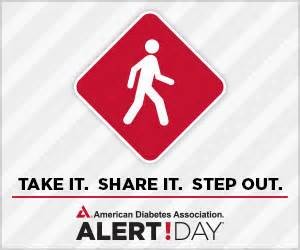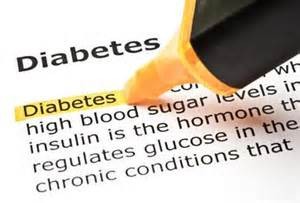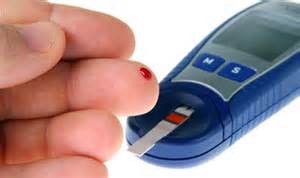 Today, March 24, 2015, is the American Diabetes Association Alert Day®. If you’ve never heard of it, it is held the fourth Tuesday of March each year. On this day, the American Diabetes Association brings awareness of diabetes to the American public by asking everyone to “Take it. Share it.” The “it” in this case is the diabetes risk test. It only takes one to two minutes to complete and gives you an estimated risk of developing diabetes based on gender, race, age, and family history. Once finished, it is even easier to share the risk test with your family and friends through your favorite social media or email. But why is it so important?
Today, March 24, 2015, is the American Diabetes Association Alert Day®. If you’ve never heard of it, it is held the fourth Tuesday of March each year. On this day, the American Diabetes Association brings awareness of diabetes to the American public by asking everyone to “Take it. Share it.” The “it” in this case is the diabetes risk test. It only takes one to two minutes to complete and gives you an estimated risk of developing diabetes based on gender, race, age, and family history. Once finished, it is even easier to share the risk test with your family and friends through your favorite social media or email. But why is it so important?
The Centers for Disease Control and Prevention (CDC) estimate that more than 29 million Americans have diabetes, and 8 million of those are undiagnosed.  That is almost 30% who do not know they have diabetes! Uncontrolled diabetes can increase risk for cardiovascular disease, stroke, blindness, kidney failure, and amputation. Furthermore, diabetes was ranked as the seventh leading cause of death in the U.S. by the CDC in 2010. The American Diabetes Association states that in 2012 there were 86 million Americans age 20 and older that have prediabetes. These are just a couple reasons why it is so important to be tested, or at the very least take the risk assessment test.
That is almost 30% who do not know they have diabetes! Uncontrolled diabetes can increase risk for cardiovascular disease, stroke, blindness, kidney failure, and amputation. Furthermore, diabetes was ranked as the seventh leading cause of death in the U.S. by the CDC in 2010. The American Diabetes Association states that in 2012 there were 86 million Americans age 20 and older that have prediabetes. These are just a couple reasons why it is so important to be tested, or at the very least take the risk assessment test.
To give a little background, diabetes is a disease that prevents the body from properly using glucose ingested as energy. There are several types of diabetes. Type 1 diabetes develops when the body’s immune system destroys beta cells in the pancreas, which prevents or severely limits the amount of insulin released, which prevents the muscles from absorbing the glucose to use as energy. Type 1.5 or latent autoimmune diabetes in adults (LADA) is more common than Type 1 and more is being learned about this type of diabetes. In LADA there is a slower progression of autoimmune diabetes, but progresses to needing full insulin support over time.  Type 2 diabetes is generally diagnosed in older adults, but can be diagnosed in children and is the result of insulin resistance, when the muscle and liver cells have difficulty recognizing the insulin and the beta cells lose the ability to produce it in sufficient quantity. A third type, gestational diabetes, is typically diagnosed during the second and third trimester of pregnancy. Those who are diagnosed are not necessarily diagnosed before pregnancy, and do not always continue to have high blood sugar after pregnancy. More information about all types of diabetes can be found from the American Diabetes Association and the CDC.
Type 2 diabetes is generally diagnosed in older adults, but can be diagnosed in children and is the result of insulin resistance, when the muscle and liver cells have difficulty recognizing the insulin and the beta cells lose the ability to produce it in sufficient quantity. A third type, gestational diabetes, is typically diagnosed during the second and third trimester of pregnancy. Those who are diagnosed are not necessarily diagnosed before pregnancy, and do not always continue to have high blood sugar after pregnancy. More information about all types of diabetes can be found from the American Diabetes Association and the CDC.
 The information from the American Diabetes Association and the CDC are not meant to scare you, just make you aware. If you are concerned about your risk for diabetes or any other health concern, please speak with your doctor or healthcare provider. Diabetes can be prevented, delayed, and managed once diagnosed. If you are at risk for diabetes or have prediabetes, evidence shows that increasing physical activity and a healthy diet, including fruits, vegetables, and whole grains, may cut the risk of developing type 2 diabetes in half. For more prevention tips, see Megan’s blog post from Diabetes Awareness month. And remember, if you plan on changing your physical activity or diet, please speak with your doctor first. So this Diabetes Alert Day don’t forget to “Take it. Share it.”
The information from the American Diabetes Association and the CDC are not meant to scare you, just make you aware. If you are concerned about your risk for diabetes or any other health concern, please speak with your doctor or healthcare provider. Diabetes can be prevented, delayed, and managed once diagnosed. If you are at risk for diabetes or have prediabetes, evidence shows that increasing physical activity and a healthy diet, including fruits, vegetables, and whole grains, may cut the risk of developing type 2 diabetes in half. For more prevention tips, see Megan’s blog post from Diabetes Awareness month. And remember, if you plan on changing your physical activity or diet, please speak with your doctor first. So this Diabetes Alert Day don’t forget to “Take it. Share it.”
Don’t forget to check out our services for helping people with diabetes thrive, including grocery store tours, 1-on-1 counseling, and more!
by Margaret Merlie
Eat Fit Health Intern
Graduate Student, Drexel University
MS in Human Nutrition, 2015